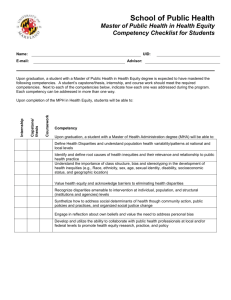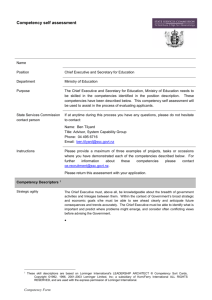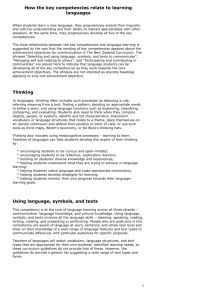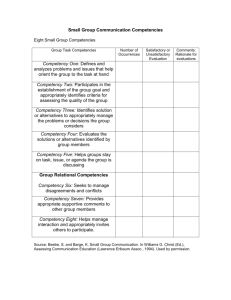Internal Equity
advertisement
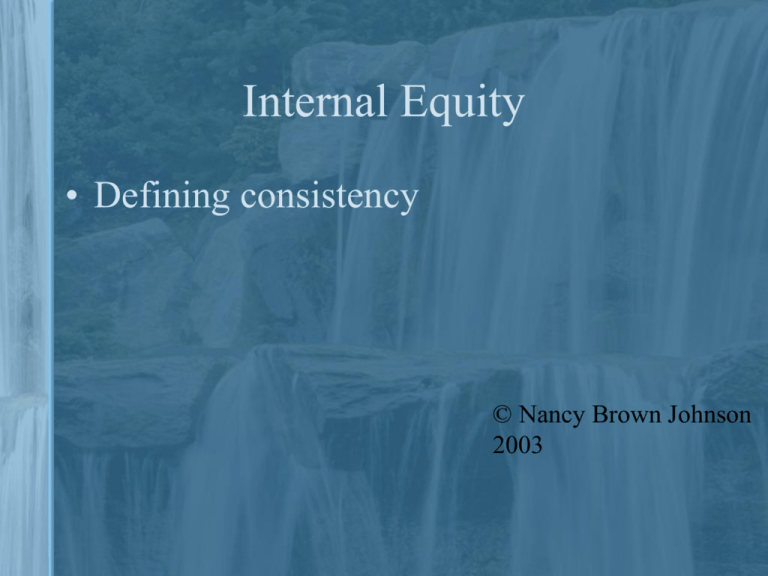
Internal Equity • Defining consistency © Nancy Brown Johnson 2003 Elements of the Pay Structure • Levels & Reporting Relationships • Differentials 1. 1. Which of the following jobs are the most important? 2. Why? 3. Are there conditions under which this would change the ordering? 4. How much more are they worth? – – – – – – – – Clerk Accountant Lawyer Production Supervisor Production Manager Operator HR Manager Information Systems Supervisor Internal Equity is about the fairness of the pay structure • CEO Pay • More CEO Pay Internal Consistency • Job’s worth to the employer • Ranking of jobs in the organization What is a job? • A job is socially constructed • Used to organize work • Other ways of valuing work – Pay based upon job – Pay the individual • Why don’t we do this? – Opens opportunity for exploitation – Discrimination What are problems with jobs? What is the alternative? • Rigid, inflexible • Change slowly – To change you need to rewrite a person’s job description • Alternative are flexible teams – More focus on sharing work – More focus on multiple skills – Communication becomes more important • Question: How do we select, pay & train people in de-jobbed world? How do we organize work? How is fairness insured? From: Bridges, William, “The End of the Job” Fortune, 9/19/94. Why might employers choose to have a pay structure that differs from the external market? Internal Labor Markets • Organizations have ports of entry – these governed by external labor markets • The pricing & allocation of labor is governed by the organization’s internal procedures • Once in organization then internal labor markets governed by the organization’s rule • The pay structure enforces the relationships among workers and reinforces longer term relationships with employees. Egalitarian v. Hierarchical Structure • Egalitarian: flat structure little difference between the top and the bottom – more equal treatment – employee satisfaction – teamwork • Hierarchical: explicitly recognizes differences in skills & responsibilities – motivation Pilot compensation First Officer Year 1 First Officer Year 5 Captain, Captain, Small Max Aircraft Year 10 Southwest $36,132 $82,068 $140, 412 $143,508 American 25,524 67,092 132,276 185,004 Delta 33,396 95,040 112,308 209,388 United 29,808 95,100 128,124 200,796 Avg.(A,D, U) 29,576 85,744 124,236 198,396 Source: Gerhart & Rynes, Compensation, 2003. Factors that influence internal wage structures • Society – just price doctrine • occupation’s station determines value • social values determine wages • Sociological – Hierarchal level predicts job worth – People believe pay level for one position should be 1.3 to 1.4 higher than next lower position – Concludes: organizational level significant factor in predicting the worth of positions • Winner take all – Best performance wins big (e.g., Michael Jordan, CEOs) – Small differences in performance worth a great deal Demand Side Models of Pay Structures • Marginal Productivity • pay based on contributions to firm productivity • Time Span of Discretion – How much time you work without review Supply side models of internal equity • Human Capital – pay based on investments in HC: education, skill, experience – general human capital • of value to many employers – specific human capital • training paid for by employer • employer earns equity • Labor’s Scarcity Model – Factors that make labor scarce make it more valuable • Institutional – Pay based imitation of other employers Organizational Factors • Technology – work performed – skills to perform work • HR Policies & Strategy • Strategic skill Relative Role of Internal v. External Equity • Do managers place more weight on external or internal equity? – Why? • Would this change in a world with no jobs? Employee Acceptance Key Test • Beliefs about what are reasonable differences • Distributive justice: satisfaction with outcomes • Procedural justice: satisfaction with process Internal Equity in Practice • Job analysis – Collecting data about jobs • Job evaluation – Valuing jobs Job Analysis • Gathering information about work – Behaviors – Tasks – Critical Incidents Job Analysis Result • Job description: – job based – tasks – work performed • Job Specification – employee based – knowledge, skills & abilities – experience Evaluating Work: Job Evaluation Determining a job’s worth to the organization. Internal equity. Four Job Evaluation Methods Whole Job Specific Job Factors Job v. Job Ranking Factor Comparison Job v. Standards Classification Point Factor Ranking • Rank Jobs highest to lowest • Paired comparison Shear Operator Electrician Punch Press Welder Grinder E S M S M M E P M Electrician E Punch Press Welder Grinder Receiving Clerk S E P M G Classification • Like library Class I classification system Simple work, no supervisory • Define categories and responsibility, no public contact then compare job Class II against categories Simple work, no supervisory responsibility, public contact Class III Medium work complexity, no supervisory responsibility, public contact Point Factor Method Steps: 1. Decide compensable factors: what the organization wants to pay for skill, effort responsibility & working conditions 2. Set scales for the factors 3. Weight the factors 4. Evaluate the jobs Point Factor Method Working Conditions 1. Hazardous work deals with dangerous materials or working conditions 2. Uncomfortable work loud, hot or cold, dirty 3. Good working conditions office environment, air conditioned, good lighting Education 1. Job requires graduate education 2. Job requires bachelor degree 3. Job requires high school education Effect of Error 1. Major mistake-more than $500,000 2. Major mistake-more than $100,000 3. Major mistake-less than $99,999 1=10 points, 2-8 points, 3=5 points Job Evaluation • Judgement involved • Statistical weighting • Employee Acceptance Jobs v. Skills or Competencies • Jobs – – – – clear expectations sense of progress pay based on value of work inflexible • Skills or Competencies – continuous learning – flexibility – lateral movement Skill & Competency Analysis • Skill Analysis: systematic process to identify skills to perform work: – What you know. – Skills: basic unit of knowledge • Competency Analysis: systematic process to identify competencies required to for success. – What you can do. – Competencies: basic units of knowledge & abilities Skill or Competency Evaluation • Person centered approach rather than job centered • Determine the skill blocks that are valued: skill or skill units, rather than jobs are compensable. – Quantify the value – Develop certification procedures – Mastery of skill units is measured and certified. • Pay changes do not necessarily accompany job changes. • There is little emphasis on seniority in pay determination. The Top Twenty Competencies • • • • • • • • • • Achievement orientation Concern of quality Initiative Interpersonal understanding Customer-service orientation Influence and impact Organization awareness Networking Directiveness Teamwork & cooperation • Developing others • Team leadership • Technical expertise • Information seeking • Analytical thinking • Conceptual thinking • Self-control • Self-confidence • Business orientation • Flexibility Competency Analysis Criticisms • Competencies sometimes vague: “Can do attitude” • Some competencies difficult to measure: can’t give a test • Difficult to relate to what people do – Could expect a competency that they don’t engage in Alternative to Job Evaluation • Market Pricing • Assumes the firm’s values irrelevant • Most likely done when employees only hired externally and rarely promoted from within Summary • Internal equity is job’s value (job evaluation) or a person’s value (competency analysis) to organization • Established through job evaluation or competency analysis • Alternative is to price jobs according to market value
